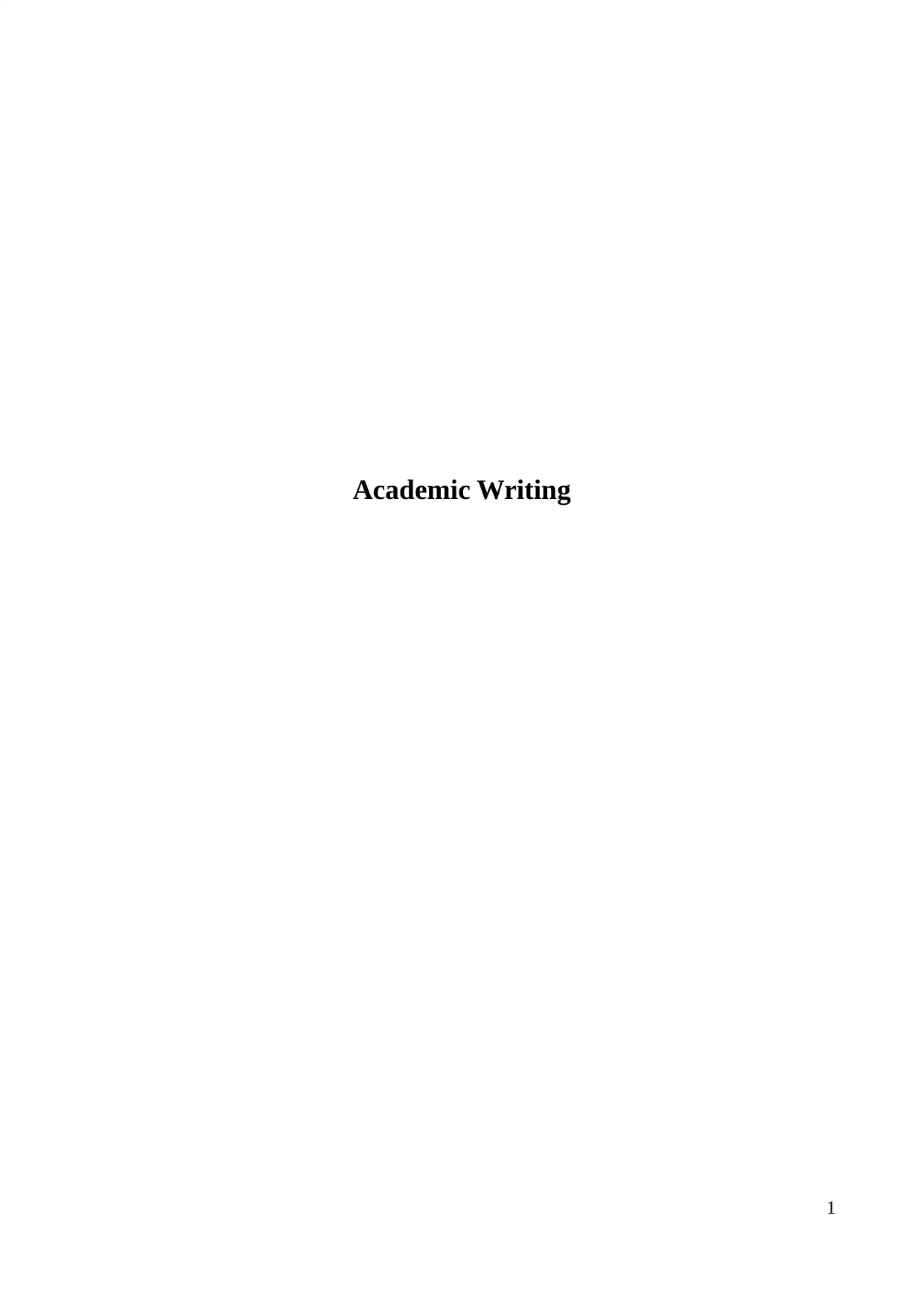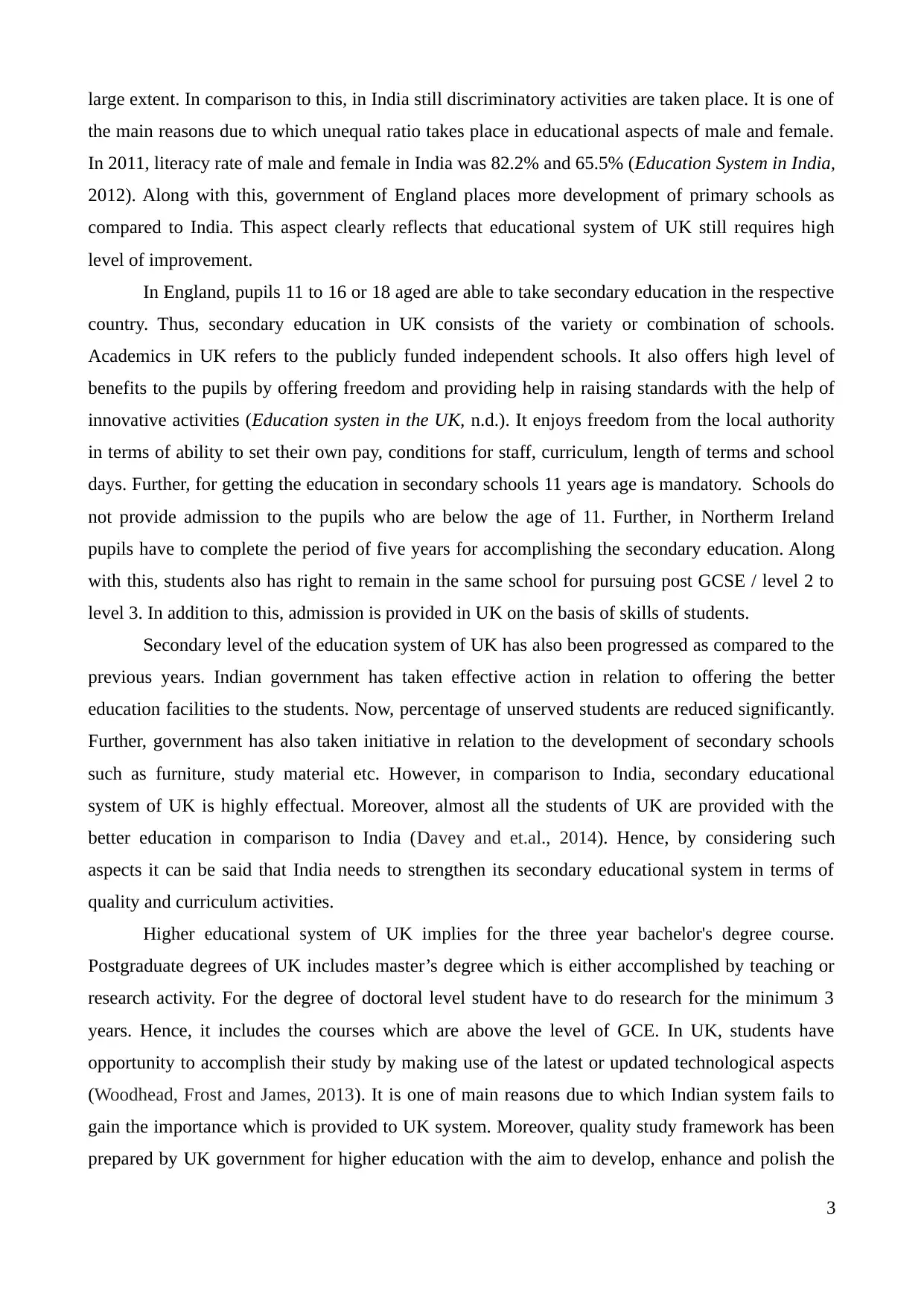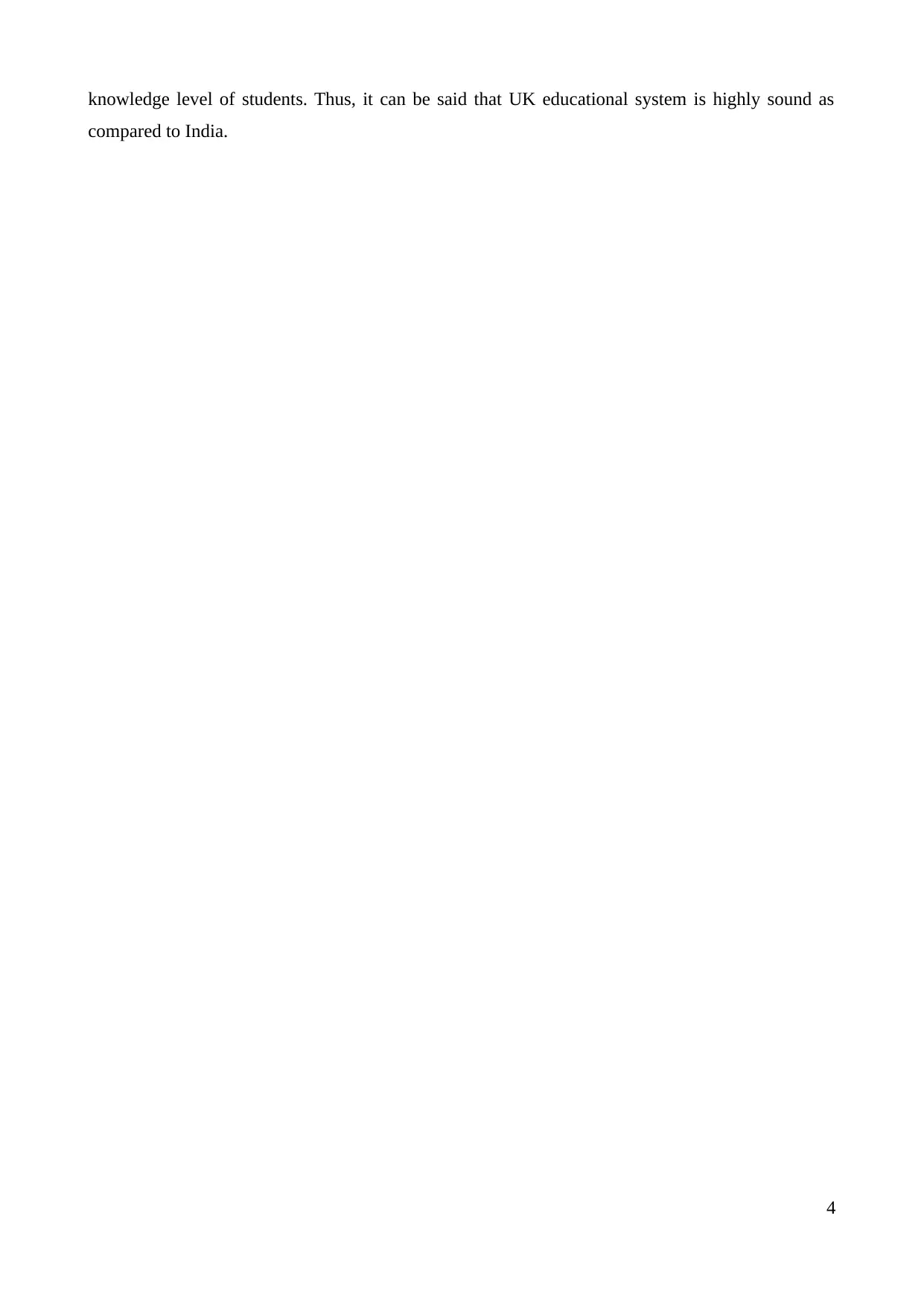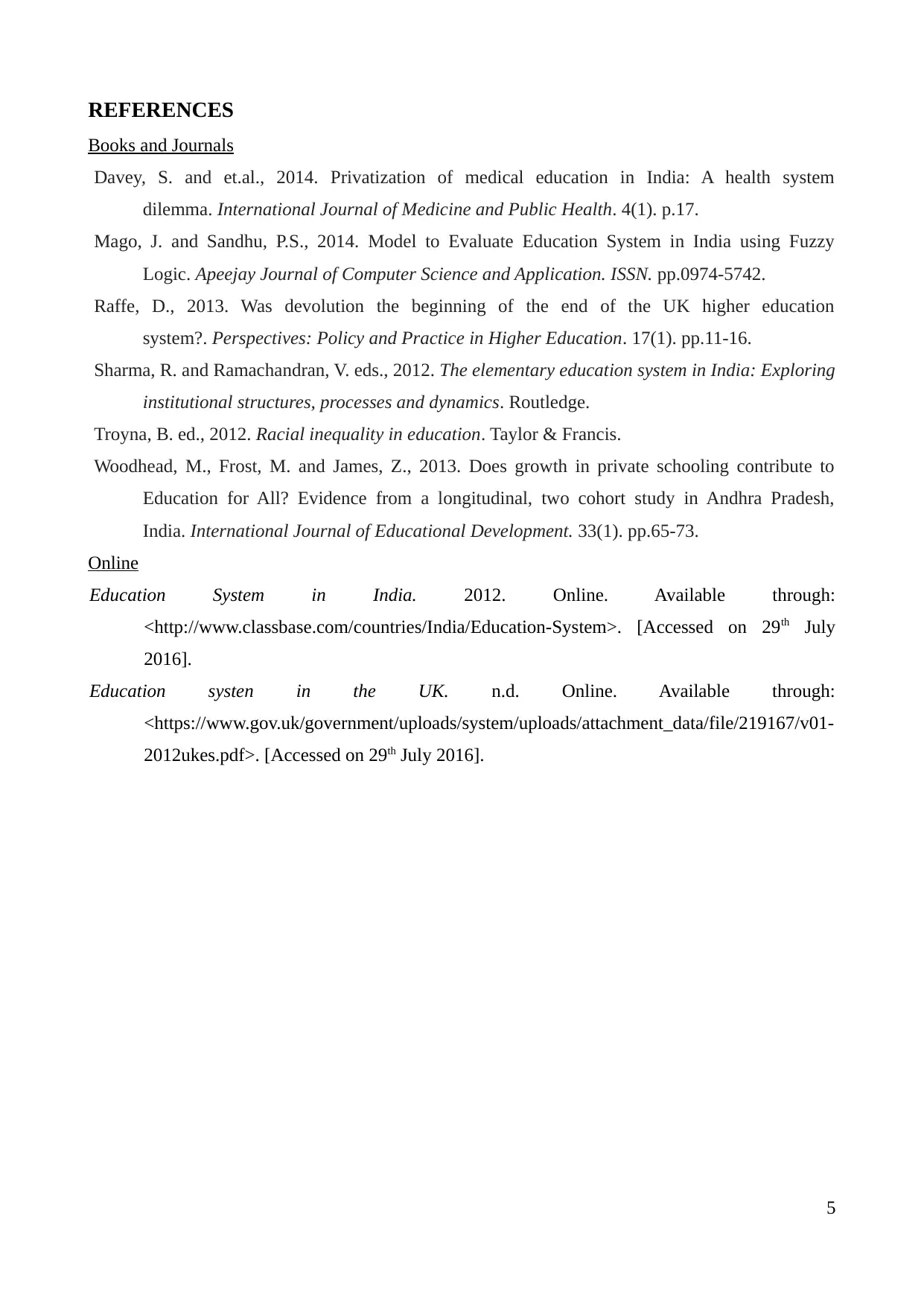Comparative Essay: Examining UK and Indian Education Systems
VerifiedAdded on 2019/12/28
|5
|1422
|2038
Essay
AI Summary
This essay provides a comparative analysis of the education systems in the United Kingdom and India, examining primary, secondary, and higher education levels. It highlights key differences, such as the role of government funding, parental choice, and literacy rates. The essay discusses the structure and objectives of primary education in both countries, including the emphasis on literacy and numeracy in the UK and the initiatives to improve attendance and literacy in India. It then delves into secondary education, comparing the flexibility and independence of UK academics with the efforts to develop secondary schools in India. Finally, the essay explores higher education, contrasting the three-year bachelor's degree in the UK with the challenges faced by the Indian system. The essay concludes by suggesting that the UK system is more effective overall and that India needs to strengthen its secondary education system. The essay references various books and journals to support its arguments.

Academic Writing
1
1
Paraphrase This Document
Need a fresh take? Get an instant paraphrase of this document with our AI Paraphraser

TOPIC: COMPARISON OF UK EDUCATION SYSTEM WITH INDIA
Education system refers to the ways which are employed by the respective country for
enhancing the learning and knowledge level of people. Literacy rate of the each country is highly
influenced by the education system takes place in it. It is the responsibility of the government to
encourage their citizen towards learning and to become literate person (Troyna, 2012). In the
present era, government emphasizes on the raising awareness of the people towards the educational
aspects. In this essay, difference between the educational system of UK and India will be discussed.
This essay will shed light the primary, secondary and higher education system of UK and India.
Through this, one can determine the extent to which the education system of specific country is
better.
In UK, educational aspects are monitored by the United Kingdom's Department for
education. In this, local government authorities of UK have responsibility to implement the policy
and strategic framework in the best possible manner. Further, they are also assigned with the task to
provide suitable amount of fund to the schools at local level. In England, there is the tradition
towards independent and home schooling. In this regard, parents of the child have right to choose
the means of education (Sharma and Ramachandran, 2012). State funded education system of UK
can be divided into two stages on the basis of aspects. In this, children of 3-5 years lie in the
category of early year’s education. On the other hand, children of 7-11 years are able to take
primary education. Developing basic literacy and numeracy among all the pupils is one of the main
objectives of UK government (Raffe, 2013). In primary education, more focus is made by the
government on establishing foundation in relation to the subjects of science, mathematics and
others.
Besides this, in India education is provided by both public as well as private sector. In India
awareness towards the educational aspects are increasing with the very high pace. Under Indian
constitution, there is a fundamental right is provided to the children who are in the ages of 6 to 14 in
terms of free and compulsory education (Mago and Sandhu, 2014). Ratio of 7:5 takes place in India
in relation to public to private. In the present times, primary education attendance rate and literacy
rate in Indian is increasing with the high rate. Literacy rate of India was 74% in the year of 2011. In
this, ratio of female literacy is lower than the male.
On the basis of all the above mentioned aspects it can be stated that primary education
system of UK is highly effectual as compared to India. Moreover, in UK parents and government
offers equal opportunity to the children in terms of education. UK does discriminate children on the
basis of sex such as male and female. Thus, in UK equal rights are provided to the children to the
2
Education system refers to the ways which are employed by the respective country for
enhancing the learning and knowledge level of people. Literacy rate of the each country is highly
influenced by the education system takes place in it. It is the responsibility of the government to
encourage their citizen towards learning and to become literate person (Troyna, 2012). In the
present era, government emphasizes on the raising awareness of the people towards the educational
aspects. In this essay, difference between the educational system of UK and India will be discussed.
This essay will shed light the primary, secondary and higher education system of UK and India.
Through this, one can determine the extent to which the education system of specific country is
better.
In UK, educational aspects are monitored by the United Kingdom's Department for
education. In this, local government authorities of UK have responsibility to implement the policy
and strategic framework in the best possible manner. Further, they are also assigned with the task to
provide suitable amount of fund to the schools at local level. In England, there is the tradition
towards independent and home schooling. In this regard, parents of the child have right to choose
the means of education (Sharma and Ramachandran, 2012). State funded education system of UK
can be divided into two stages on the basis of aspects. In this, children of 3-5 years lie in the
category of early year’s education. On the other hand, children of 7-11 years are able to take
primary education. Developing basic literacy and numeracy among all the pupils is one of the main
objectives of UK government (Raffe, 2013). In primary education, more focus is made by the
government on establishing foundation in relation to the subjects of science, mathematics and
others.
Besides this, in India education is provided by both public as well as private sector. In India
awareness towards the educational aspects are increasing with the very high pace. Under Indian
constitution, there is a fundamental right is provided to the children who are in the ages of 6 to 14 in
terms of free and compulsory education (Mago and Sandhu, 2014). Ratio of 7:5 takes place in India
in relation to public to private. In the present times, primary education attendance rate and literacy
rate in Indian is increasing with the high rate. Literacy rate of India was 74% in the year of 2011. In
this, ratio of female literacy is lower than the male.
On the basis of all the above mentioned aspects it can be stated that primary education
system of UK is highly effectual as compared to India. Moreover, in UK parents and government
offers equal opportunity to the children in terms of education. UK does discriminate children on the
basis of sex such as male and female. Thus, in UK equal rights are provided to the children to the
2

large extent. In comparison to this, in India still discriminatory activities are taken place. It is one of
the main reasons due to which unequal ratio takes place in educational aspects of male and female.
In 2011, literacy rate of male and female in India was 82.2% and 65.5% (Education System in India,
2012). Along with this, government of England places more development of primary schools as
compared to India. This aspect clearly reflects that educational system of UK still requires high
level of improvement.
In England, pupils 11 to 16 or 18 aged are able to take secondary education in the respective
country. Thus, secondary education in UK consists of the variety or combination of schools.
Academics in UK refers to the publicly funded independent schools. It also offers high level of
benefits to the pupils by offering freedom and providing help in raising standards with the help of
innovative activities (Education systen in the UK, n.d.). It enjoys freedom from the local authority
in terms of ability to set their own pay, conditions for staff, curriculum, length of terms and school
days. Further, for getting the education in secondary schools 11 years age is mandatory. Schools do
not provide admission to the pupils who are below the age of 11. Further, in Northerm Ireland
pupils have to complete the period of five years for accomplishing the secondary education. Along
with this, students also has right to remain in the same school for pursuing post GCSE / level 2 to
level 3. In addition to this, admission is provided in UK on the basis of skills of students.
Secondary level of the education system of UK has also been progressed as compared to the
previous years. Indian government has taken effective action in relation to offering the better
education facilities to the students. Now, percentage of unserved students are reduced significantly.
Further, government has also taken initiative in relation to the development of secondary schools
such as furniture, study material etc. However, in comparison to India, secondary educational
system of UK is highly effectual. Moreover, almost all the students of UK are provided with the
better education in comparison to India (Davey and et.al., 2014). Hence, by considering such
aspects it can be said that India needs to strengthen its secondary educational system in terms of
quality and curriculum activities.
Higher educational system of UK implies for the three year bachelor's degree course.
Postgraduate degrees of UK includes master’s degree which is either accomplished by teaching or
research activity. For the degree of doctoral level student have to do research for the minimum 3
years. Hence, it includes the courses which are above the level of GCE. In UK, students have
opportunity to accomplish their study by making use of the latest or updated technological aspects
(Woodhead, Frost and James, 2013). It is one of main reasons due to which Indian system fails to
gain the importance which is provided to UK system. Moreover, quality study framework has been
prepared by UK government for higher education with the aim to develop, enhance and polish the
3
the main reasons due to which unequal ratio takes place in educational aspects of male and female.
In 2011, literacy rate of male and female in India was 82.2% and 65.5% (Education System in India,
2012). Along with this, government of England places more development of primary schools as
compared to India. This aspect clearly reflects that educational system of UK still requires high
level of improvement.
In England, pupils 11 to 16 or 18 aged are able to take secondary education in the respective
country. Thus, secondary education in UK consists of the variety or combination of schools.
Academics in UK refers to the publicly funded independent schools. It also offers high level of
benefits to the pupils by offering freedom and providing help in raising standards with the help of
innovative activities (Education systen in the UK, n.d.). It enjoys freedom from the local authority
in terms of ability to set their own pay, conditions for staff, curriculum, length of terms and school
days. Further, for getting the education in secondary schools 11 years age is mandatory. Schools do
not provide admission to the pupils who are below the age of 11. Further, in Northerm Ireland
pupils have to complete the period of five years for accomplishing the secondary education. Along
with this, students also has right to remain in the same school for pursuing post GCSE / level 2 to
level 3. In addition to this, admission is provided in UK on the basis of skills of students.
Secondary level of the education system of UK has also been progressed as compared to the
previous years. Indian government has taken effective action in relation to offering the better
education facilities to the students. Now, percentage of unserved students are reduced significantly.
Further, government has also taken initiative in relation to the development of secondary schools
such as furniture, study material etc. However, in comparison to India, secondary educational
system of UK is highly effectual. Moreover, almost all the students of UK are provided with the
better education in comparison to India (Davey and et.al., 2014). Hence, by considering such
aspects it can be said that India needs to strengthen its secondary educational system in terms of
quality and curriculum activities.
Higher educational system of UK implies for the three year bachelor's degree course.
Postgraduate degrees of UK includes master’s degree which is either accomplished by teaching or
research activity. For the degree of doctoral level student have to do research for the minimum 3
years. Hence, it includes the courses which are above the level of GCE. In UK, students have
opportunity to accomplish their study by making use of the latest or updated technological aspects
(Woodhead, Frost and James, 2013). It is one of main reasons due to which Indian system fails to
gain the importance which is provided to UK system. Moreover, quality study framework has been
prepared by UK government for higher education with the aim to develop, enhance and polish the
3
⊘ This is a preview!⊘
Do you want full access?
Subscribe today to unlock all pages.

Trusted by 1+ million students worldwide

knowledge level of students. Thus, it can be said that UK educational system is highly sound as
compared to India.
4
compared to India.
4
Paraphrase This Document
Need a fresh take? Get an instant paraphrase of this document with our AI Paraphraser

REFERENCES
Books and Journals
Davey, S. and et.al., 2014. Privatization of medical education in India: A health system
dilemma. International Journal of Medicine and Public Health. 4(1). p.17.
Mago, J. and Sandhu, P.S., 2014. Model to Evaluate Education System in India using Fuzzy
Logic. Apeejay Journal of Computer Science and Application. ISSN. pp.0974-5742.
Raffe, D., 2013. Was devolution the beginning of the end of the UK higher education
system?. Perspectives: Policy and Practice in Higher Education. 17(1). pp.11-16.
Sharma, R. and Ramachandran, V. eds., 2012. The elementary education system in India: Exploring
institutional structures, processes and dynamics. Routledge.
Troyna, B. ed., 2012. Racial inequality in education. Taylor & Francis.
Woodhead, M., Frost, M. and James, Z., 2013. Does growth in private schooling contribute to
Education for All? Evidence from a longitudinal, two cohort study in Andhra Pradesh,
India. International Journal of Educational Development. 33(1). pp.65-73.
Online
Education System in India. 2012. Online. Available through:
<http://www.classbase.com/countries/India/Education-System>. [Accessed on 29th July
2016].
Education systen in the UK. n.d. Online. Available through:
<https://www.gov.uk/government/uploads/system/uploads/attachment_data/file/219167/v01-
2012ukes.pdf>. [Accessed on 29th July 2016].
5
Books and Journals
Davey, S. and et.al., 2014. Privatization of medical education in India: A health system
dilemma. International Journal of Medicine and Public Health. 4(1). p.17.
Mago, J. and Sandhu, P.S., 2014. Model to Evaluate Education System in India using Fuzzy
Logic. Apeejay Journal of Computer Science and Application. ISSN. pp.0974-5742.
Raffe, D., 2013. Was devolution the beginning of the end of the UK higher education
system?. Perspectives: Policy and Practice in Higher Education. 17(1). pp.11-16.
Sharma, R. and Ramachandran, V. eds., 2012. The elementary education system in India: Exploring
institutional structures, processes and dynamics. Routledge.
Troyna, B. ed., 2012. Racial inequality in education. Taylor & Francis.
Woodhead, M., Frost, M. and James, Z., 2013. Does growth in private schooling contribute to
Education for All? Evidence from a longitudinal, two cohort study in Andhra Pradesh,
India. International Journal of Educational Development. 33(1). pp.65-73.
Online
Education System in India. 2012. Online. Available through:
<http://www.classbase.com/countries/India/Education-System>. [Accessed on 29th July
2016].
Education systen in the UK. n.d. Online. Available through:
<https://www.gov.uk/government/uploads/system/uploads/attachment_data/file/219167/v01-
2012ukes.pdf>. [Accessed on 29th July 2016].
5
1 out of 5
Related Documents
Your All-in-One AI-Powered Toolkit for Academic Success.
+13062052269
info@desklib.com
Available 24*7 on WhatsApp / Email
![[object Object]](/_next/static/media/star-bottom.7253800d.svg)
Unlock your academic potential
Copyright © 2020–2025 A2Z Services. All Rights Reserved. Developed and managed by ZUCOL.





